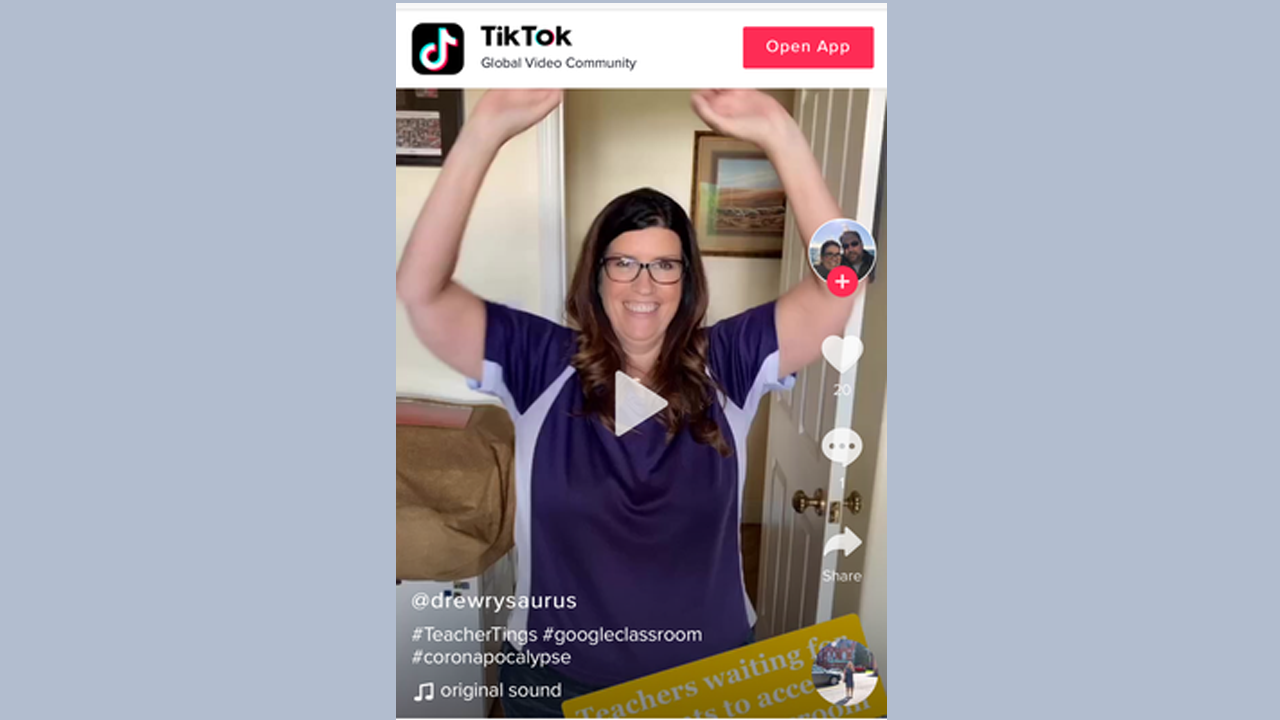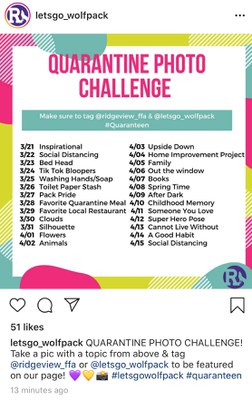
School is Still in Session - Just at a Distance
Kathy Drewry makes TikTok videos – there’s one where she lip syncs a snippet from King George’s “What Comes Next” song in Hamilton and another where she dances to Move Dat by Nahzzy & Legend. She’s an active Twitter user and regularly hosts Facebook and Instagram live sessions. “I have always used social media to connect,” she explains. After years of social media usage (yes, she had a MySpace account), her social media game has become increasingly strategic – different platforms are leveraged for different purposes. For example, she uses Twitter for work and the news, and Facebook as a “Christmas card for the world – with only good news….”
Drewry is leveraging her social media abilities during this COVID-19 crisis. The longtime history-social science teacher (and Department Chair) at Ridgeview High School in Bakersfield, sees social media as a critical tool, “...to provide a social context and ‘normalcy’…” for her students. Ridgeview and the rest of the schools in the Kern High School District (KHSD) closed on March 18. This week, KHSD announced plans to reopen Bakersfield high schools on May 5. In the interim, the district has explained that distance learning remains “…a priority,” and is doing its best to address gaps in online access, as Drewry explained: “All of our high schools are now checking Chromebooks out to students, and trying to push our wifi out to our parking lots, with the idea that they can drive into the parking lot to download and upload material, and then work offline at home if necessary. (Our Chromebooks only work on our district wifi.) We also have buses equipped with wifi, that we are planning to send out to neighborhoods for ‘hotspots.’”
If KHSD is able to keep its planned May 5 opening, that means that students in Bakersfield will have missed almost two months of in-person schooling. Drewry and her colleagues are determined to help their students, despite school closure. As Drewry explains, “School is still in session, just at a distance.” Drewry teaches 10th Grade World History, 11th Grade US History, and 12th Grade Government and Economics. Students in each of her classes are asked to complete journals daily, in order to document their experiences living through the crisis. “One day,” she wrote, “students will be studying the past and reading through first hand accounts of the Covid-19 pandemic in their history classes. So, let’s create some primary sources for the future!” In addition to their journals, her students are expected to complete weekly inquiry-based assignments that she posts in each course’s Google Classroom. Because Drewry’s students have been doing inquiry all year, this assignment is familiar to them. As she explained in her directions, “these lessons will require you to read through documents, examine pictures and data, and respond to questions and writing prompts, like we’ve done in class.”
 At the same time she attends to her students’ academic progress, Drewry also tries to maintain connections with her students – and they with each other. “Students feel connected to a campus they're not allowed to walk on, and they feel connected to one another as they see each other's posts and pictures,” she explained. “…teachers that use social media on our campus have ramped up their presence with the shut down.” In addition to her own posts, Drewry credits her Principal Steve Holmes' leadership (“a really great guy”) and her colleagues’ creativity for keeping teachers motivated and students engaged and supported. “Many on our campuses are trying to provide a "normal school setting" through social media… our activities director is promoting a spirit dress up week through the shutdown. Students are encouraged to play along and post their own pictures in their costumes each day.” Even the school’s Future Farmers of American (FFA) teacher is getting into the act, by hosting a photo challenge with a different subject each day.
At the same time she attends to her students’ academic progress, Drewry also tries to maintain connections with her students – and they with each other. “Students feel connected to a campus they're not allowed to walk on, and they feel connected to one another as they see each other's posts and pictures,” she explained. “…teachers that use social media on our campus have ramped up their presence with the shut down.” In addition to her own posts, Drewry credits her Principal Steve Holmes' leadership (“a really great guy”) and her colleagues’ creativity for keeping teachers motivated and students engaged and supported. “Many on our campuses are trying to provide a "normal school setting" through social media… our activities director is promoting a spirit dress up week through the shutdown. Students are encouraged to play along and post their own pictures in their costumes each day.” Even the school’s Future Farmers of American (FFA) teacher is getting into the act, by hosting a photo challenge with a different subject each day.
Given her 24 years of teaching and (somewhat less) time on social media, Drewry offers the following advice for other teachers trying to navigate this new teaching environment -
- Temper your expectations regarding the amount of content you can cover. Drewry argues that less is more: “Don’t try to cover the amount of content you would normally in a regular classroom," she argues. Instead, she advocates for flexibility in order to meet students’ different needs.
- Keep equity in mind. Drewry’s principal reminded Ridgeview’s faculty that there are many students who don’t have regular access to the internet. As a result, Drewry and her colleagues try to design work that can be done offline and / or made up quickly once school resumes.
- Stay connected with social media – but be careful. Although Drewry is obviously comfortable using social media, and sees it as a vital tool to maintain connection with her students, she’s careful about what she posts: “Whatever we put out publicly on social media for our students can be copied and preserved for the future - so we should be careful with what we choose to put out there…I try to think before each post of how I would defend myself if anyone is offended or questions the content of a post.”
